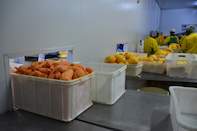
Weeding is very important during the first month after planting. Weeding can be done between the plants by using a hoe or hand pulling. Be careful not to damage the vines. Weeding will not be needed when plant leaves cover the ground. Sweet potatoes can be cultivated as a mono crop or mixed with sorghum, millet, maize, cassava, etc.
Crop rotation
Crop Rotation is essential to prevent disease and pest build-up. Sweet potatoes should not be grown more than once every 3 years on the same soil.
Suitable soil restorative crops such as peas, cabbage, beans and maize should be included in the rotation system, especially where crust formation is a problem.
Harvesting
The storage roots are usually ready for harvesting 4 months (warm areas) to 5 months (moderate areas) after planting. Soil should be soft during harvest to prevent breakage and skin damage. Withhold watering from around 30 days prior to harvesting as a way of field curing. In warm areas cut vines 4-7 days before harvesting to cure.
Use a hand-fork to lift up the storage roots and then take out by hand. Do not use a hoe or spade. Make sure not to damage storage roots in any way during harvesting. The storage roots can be harvested at once or as required. If too long season is allowed, the roots will become too large.
Rub off the soil from the sweet potatoes, wash and leave to dry in sun for 1-2 hours when temperatures are moderately high. At 32°C harvested roots can get sunscald within 30 minutes. If left on the field at night at temperatures below 5°C, chilling injury will occur. Store in cool, dry place (15°C).
Storage
Sweet potatoes can be stored fresh for 3-6 weeks after harvesting. Do not store damaged roots.
The sweet potatoes can also be left in the ground until such time as you need them. It is better to extend harvesting through planting at two-weekly intervals during the planting season.
Remember: Do not water at this stage. In cold areas low temperatures will damage the storage roots in the soil. And if temperatures are still favourable, the sweet potatoes will get too large.
Low cost storage can be done in a shallow pit in the soil. Put a layer of dry grass in the pit. Pack healthy sweet potatoes in a layer 40-50 cm deep. Cover with grass and dry soil. Close with thatched roof. The sweet potato can keep up to 4 months. Do not use this method in winter rainfall areas.
Uses
Sweet potatoes can be used in different ways
• Storage roots can be eaten raw, boiled, baked or cooked
• The tips of shoots (petioles) and young leaves can be eaten as a vegetable
• Crop residues can be used as stock feed
• Storage roots can be used to make bread, baking products, chips, jam and juice